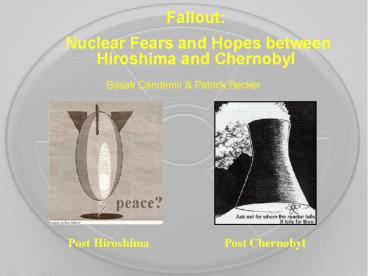Fallout: - PowerPoint PPT Presentation
Title:
Fallout:
Description:
Fallout: Nuclear Fears and Hopes between Hiroshima and Chernobyl Basak Candemir & Patrick Becker Post Hiroshima Post Chernobyl OUTLINE Introduction -- Hiroshima ... – PowerPoint PPT presentation
Number of Views:718
Avg rating:3.0/5.0
Title: Fallout:
1
Fallout Nuclear Fears and Hopes between
Hiroshima and Chernobyl
Basak Candemir Patrick Becker
Post Hiroshima
Post Chernobyl
2
OUTLINE
- Introduction -- Hiroshimaand Chernobyl as
emblems of the atomic age - Research question What changes in the meaning
and perception of nuclear power took place
between those events? - Central Argument -- The mythical cure against
nuclear fear became a pain in itself - Part 1 The Reactor Wars or the fight against
nuclear power in the 70ies and 80ies - Part 2 The Prequels (Episode I-III) or the
construction of the peaceful atom after
Hiroshima - Conclusion
3
The Reactor Wars The Fight against Nuclear
Power before Chernobyl
4
Chernobyl - The Sum of All Fears
Chernobyl is a grim reminder that nuclear power
is a technology that simply cannot be
controlled. Newsweek, May 1986
5
Chernobyl 1986 The Sum of all Fears
Image Nuclear power as a bargain with the devil
and a technology that cant be controlled
Critical Incident Chernobyl-desaster
Context Antinuclear/environmental movements and
green parties regarded as more credible sources
and opinion leaders than governmental experts
Effects De facto or de jure moratorium of
nuclear power plants in Europe and the USA
6
The Fight Against the Atom State
Atoms for peace are, in principle, not different
from atoms for war. Nuclear energy demands that
man be made safe from himself - his mistakes, his
weaknesses, and his lust for power. Protect
nuclear energy from these foibles and you run the
risk of a regimented society, and a state in a
continuous emergency. Robert Jungk, The Atom
State (1977)
7
1975-1985 The Fight Against the Atom State
Image General fear for the environmental and
societal effects of the nuclear power complex
Critical Events Antinuclear protests in Wyhl
(FRG), La Hague (F), Diablo Canyon (USA)
Near-Maximum Credible Accident at Three Miles
Island Movie The China Syndrome
Context Broad shift to post-materialistic values
Effects Growth of a strong national anti nuclear
movement Establishment of green/ alternative
parties
8
The Rude Awakening from the Big Sleep in the
Early 1970ies
Image Radioactive hazards as the Achilles Heel
of the civilian use of atomic energy
Critical Events Reports of raised radioactivity
levels around nuclear power plants First local
protests at individual construction sites
Effects Law actions against reactor
constructions and insufficient safety regulations
Alternative experts create a loss of authority
of government experts Separation of the
regulatory and promotional duties of the AEC
9
Why did the atomic fear materialize so late, and
why was it focused around the civilian use of
nuclear energy?
Every saga has its history, and so has the myth
of the peaceful atom
10
The Prequels The Construction of Images and
Meanings of Nuclear Power after Hiroshima
11
Episode I The Dark Menace
Since I do not foresee that atomic energy is to
be a great boon for a long time, I have to say
that for present, it is a menace. Albert
Einstein
12
Episode I The Dark Menace
Image Public perception of international fear
for nuclear holocaust
Critical Events Hiroshima Activities of the
Scientists Movement
Effects Defeat of the May-Johnson Bill Acheson
Lilienthal Plan (Boruch VS Gromyko)
13
Episode II A Hollow Victory
Die Geister, die ich rief werd ich nun nicht
los J.W. von Goethe
Image Fears about the proper domestic control
over atomic power
Critical Events McMahon Act Spies in the
Manhattan Project (Fuchs, etc)
Context Less atomic fear, less civilian
interference
Effects AEC (Atomic Energy Commission) created
as a semi-civilian authority stingent security
provisions
14
Episode III The Sunny Side of the Atom
15
Episode III The Sunny Side of the Atom
The military and civilian use of the atom has to
be seen as a package deal David Lilienthal, AEC
Chairman (1947-53)
Image Atomic fears soothed by new medical,
electrical and other uses Transition from
atomic bomb to nuclear power
Critical Events AEC PR campaigns, exhibitions,
and books, Our Friend the Atom Construction of
the first nuclear power plants (1957)
Effects AEC projects a peaceful and civilian
image to mask the bomb production Creation of a
nuclear energy industry
16
CONCLUSION
The Scientists struggle over the May-Johnson
Bill and their victory with the McMahon Act
(I.e., the creation of the AEC) created a shift
of meaning of atomic energy - from military use
to military and civilian use. This construction
of a civilian use was the major strategy for
legitimating the AEC as a institution under
civilian control
? Commercial use of nuclear power was the direct
product of expert agenda setting, not of
public/economic demand.
17
CONCLUSION
The image of The Peaceful Atom was successfully
constructed in the late 40s and 50s as a way for
soothing the nuclear fears, and from the 60ies
onwards, nuclear reactors became its premier
incarnation.
? From their birth, they had been seen as a part
of a grand mythical structure - and that was one
reason, as strong as economics, why they were
built. (Weart, S.R, Nuclear Fear,1988)
18
CONCLUSION
In the 1970s, the cure became the pain The image
of The Peaceful Atom was destroyed by its own
existence, and the fear that it wanted to sooth
became replaced by another fear - namely of the
peaceful use of nuclear energy and its
environmental and societal effects.
-gt The perception of nuclear power depended on
the different interpretative contexts clues
available in the 40ies and 70ies
Perception of nuclear power Late 1940ies Late 1970ies
Negative Fear of nuclear holocaust Fear of widespread civilian use of nuclear energy
Positive Peaceful uses of nuclear energy (Nuclear deterrence prevents nuclear holocaust)

